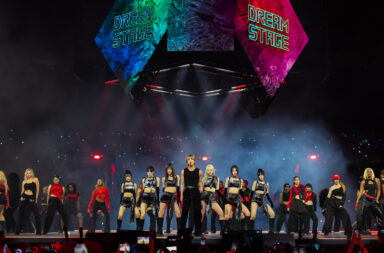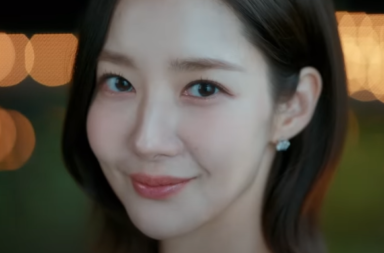
With the growing attention on K-pop idols over the past decade or so, we’re no strangers to seeing images and videos of idols pushing through dense crowds of screaming fans to get anywhere. The idea of an idol and screaming fans go hand in hand and almost difficult to separate nowadays. Her Private Life is a TvN drama that flips the focus from an idol’s life to a fan’s life. Shining a positive light onto fandom — although intense in her nature — she draws the best in a community cast under a negative hue from the actions of a few
Her Private Life tells of the story of the multiple lives of Sung Deok-mi (Park Min-young), a professional Art Museum curator and a secretly devoted idol fan that manages a popular fan site in her spare time.
We see glimpses of character similarities to Kim Mi-soo from What’s Wrong Secretary Kim also played by Park Min-Young. A strong willed, dedicated and diligent employee whose achievements are high-jacked by her superiors, leaving her in the background. This romantic comedy, however, holds an exciting difference to its predecessors. Deok-mi is a hard-core idol fan who doesn’t necessarily subscribe to the typical notions of what idol fans may seem to most: exclusive to screaming young girls.
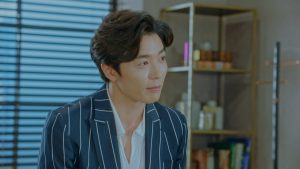
The new Director hits town to take over from the previous dramatic boss, Eom So-hye played by the hilarious Kim Sun-young. Ryan Gold (Kim Jae-wook) is a well-known artist returning to Korea to become director of the Art Museum. At first, he comes across as the archetypal cold and standoffish boss with a scarring upbringing that leads him to be so. Fortunately, as the drama unfolds we can begin to see other sides to his character as he quickly assumes the position of the new love interest too.
Watching the first 8 episodes of Her Private Life there are many themes and motifs used to show the complexity of the world of fandom. For one, Deok-mi doesn’t fit the mould of “young girl”, but she challenges this stereotype as Fan Master of an influential Fan site. The strength of this character is evident from her determination to show love to whomever she wants and control the level of exposure to her life. Though often she is confined by social parameters, she manages to stray from stereotypes and build her own secret safe haven as an “Ajummah fan”, making her character relatable for many fans over the age of 20. With the ever-growing K-pop world, social media has played a key role in connecting people of all ages and backgrounds into a community that is all-inclusive. It’s still too early to claim it to be accepted by all socially speaking, however, the online sphere proves transformations to these stigmas. After all, young screaming fangirls will eventually grow up to be older, still-screaming fangirls.
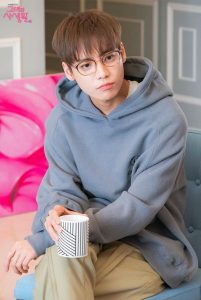
In attempt to demonstrate the levels of investment, dedication and love that are required to keep up a popular Fan site, the drama explores how the relationship between an artist and a fan is strong and personal, especially for a dedicated fan like Deok-mi. Although it’s parasocial in nature it remains powerful and effective. This is brilliantly described in the scenes in which Deok-mi tells off her childhood friend, Eun-ki for lending her an umbrella he was gifted by a girl who’s interested in him. Deok-mi stresses the sincerity and thought behind gifting someone you love so much, worrying and deeply caring for them even if they don’t notice you.
This is a key notion that is applicable in all kinds relationships, especially the kind of relation Deok-mi has created between herself and idol Shi-an (One). To illustrate the immense power the fandom’s love has on making or breaking idols’ careers, even Shi-an can hold his hand up and testify that thanks to this dedicated fan, White Ocean—his band– was rescued from malicious rumors that almost affected them.
After reading more about this relationship it’s interesting to see how theories break down this phenomenon. On a scale of parasocial relations it’s not as distinctly defined where to place a fan as parameters are often blurred. The levels vary in dedication, investment and moral compasses. The latter part of the scale infamously encompasses Sasaeng behavior . A relationship that is known for all kinds of misconduct and boundary crossing that is socially unacceptable and ruins it for the rest of the fandom.
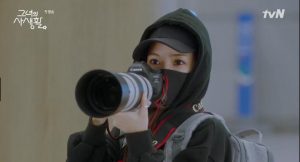
Deok-mi falls under the middle stage of interpersonal relationship. Her character is solidified in this category as she is very much invested in snapping the perfect shots of Shi-an and adorning her fan site with his beautiful face. She snaps, edits and shares this love with the others with pride and so much joy, yet the efforts for this passion comes with sacrifices of time and hard work.
The drama does well at showing fan love as more than just a crush on cute looks and addictive music that rings in your head all week. Deok-mi’s joy not only stems from seeing his face, but the emotions experienced in response to what she presents. As she explains to Lee Sun-joo (Park Jin-joo) the happiness she feels to stimulate emotions out of people that come to see the art she curates at the museum. Similarly, the manner in which she is shown presenting snaps of Shi-an on her site is a perfect example of how both of her worlds overlap in pursuit of her goal.
The ultimate goal for any fan, of course, is meeting their idol and having moment to remember. Not only does Deok-mi fulfill her goal of being noticed by Shi-an in a professional setting; she manages to keep a cool and composed persona while simultaneously fangirling and it is brilliantly portrayed in the first meeting scenes at Shi-an’s apartment. Another emphasis on the duality of her character and how relatable she is. Shi-an’s cute idiosyncrasies and or mere glances can invoke emotions on par with ripping buildings out of the ground Godzilla style!
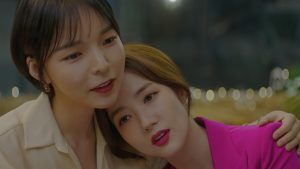
The drama does well at painting a visual image of what fans may feel and cannot explain in words. And if there is a need for using words, best friend Lee Sun-joo plays the role of in-active fan girl turned “Fairy-fan Mother”. Her character is essential in guiding anyone through the study of the fandom world, not only with terminology but also with fitting explanations for any viewer with ready-made notions to fangirling. Serving well as a buffer/reality check meter for Deok-mi in both of her secret lives. Not only that but she is helpful in painting a picture of how fangirling spark starts from early rookie stages. Her sub-narrative is portrayed comically but bares elements of truths to the phenomenon.
The first couple of episodes set the mark of the levels of love and dedication to be expected from fans. Leveling from an enjoyment of art to full-scale stakeouts outside idols’ houses. Her Private Life does well at distinguishing the differences between fans levels of dedication, intent and mental stability. With comparisons between Cindy’s fan site and Deok-mi, the lines are slowly drawn, although still blurry, between “acceptable” and commonplace fan activities and threating and unsavoury behaviour. This line begins with intent and how that usually keeps the relationship between fan and artist as should be. While often intentions, though not ill, can result in boundaries to be crossed. Some events in the drama are reminiscent of real life situations with idols that carved Sasaeng into the fandom world.

There are many other issues the drama subtly touches on which allows for an open, positive and healthy discussion. A premise that stuck with me is self worth and self-love and how that is portrayed in the drama. It’s great to see self-love and appreciation of self worth expressed by a fan. Deok-mi’s scene venting out to Ryan on realising her self worth in face of the art she works on is new to me in a drama setting. These maybe mirroring the ideologies idols preach in recent years within their art, which begins to resonate with people on a personal level. Opening discussions of self worth and empowerment is difficult as it takes effort and time to implicate but its recurrence in popular culture is promising and very positive
Another topic the drama does well about speaking of is LGBTQ representation. The topic is discussed in a positive and almost defendant manner away from prejudices. It’s refreshing to see when the reaction is not childish and ignorant, but rather breaks down the realities of the struggles same sex relationships that may be faced in Asia.
Although the overarching theme of the drama is the world of fandom and the overlooked strengths of this community, it slowly begins to take a back seat to the blooming of a reciprocal love story. Deok-mi’s other life subconsciously creates a conventional mutual exchange of emotions. This begins to take her away from being seen as just a devoted fan but as a woman falling in love with someone other than idol who is unaware of her and cannot reciprocate.
For her safety, Ryan is the one to suggest a fake relationship to keep her from Shi-an fans’ attack and constant torment after mistaking her for his girlfriend. A perfect trope used to allow the pair to unfold different sides that wouldn’t show as just director and curator. As her cosplay begins to slip out place, Ryan is there to fill in gaps that allow her to be herself and accept her in what she may see as weakness. Likewise when he needs a hand to hold, as promised, her offer stands. The two find comfort in each other and build on this opportunity of adapting to their roles.
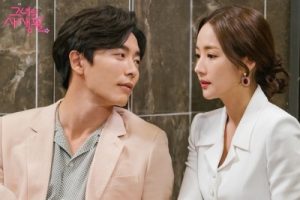
I for one enjoyed the use of a fake relationship for their character development and found it fitting to the recurring theme of adaptation. Although Ryan has now joined Deok-mi in her world of secrets, he begins to open up about his behaviour and the causes. This bubble of secret they share is the key for their character development and allows the story to progress towards a narrative of romance. It’s well illustrated in scenes where she finds her self subconsciously daydreaming of Ryan face and editing the light hitting his face at night. One noticeable concern, as a viewer with emotional attachment to the characters, is the layers of more secrets and hidden lives for Deok-mi, which makes for a higher house of cards that’s an easier target for Cindy and other sasaengs to hit.
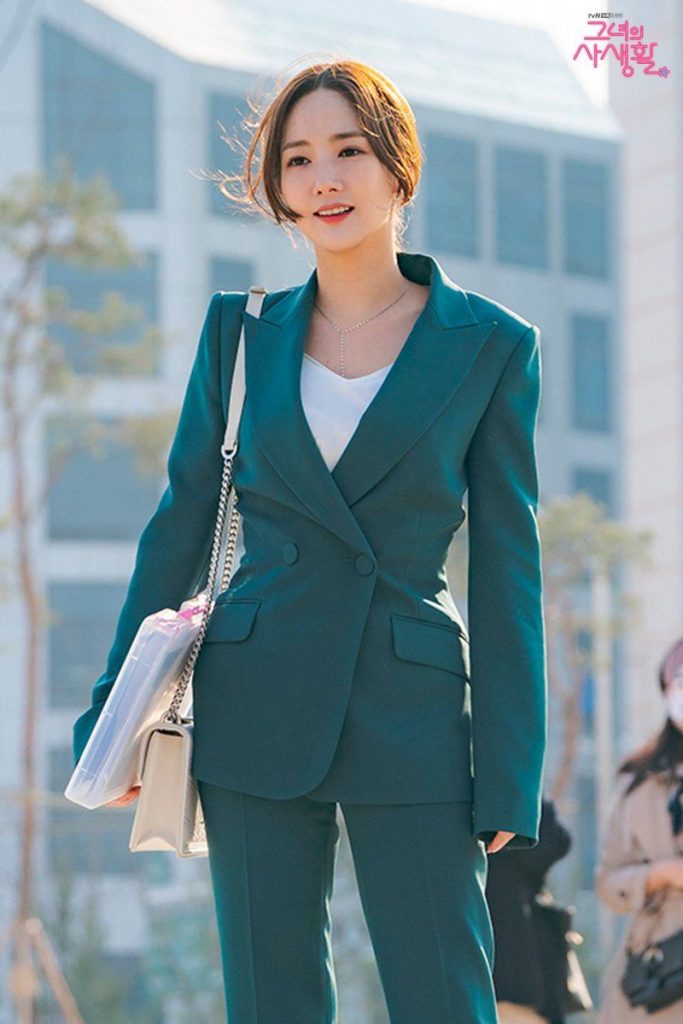
Another issue I find with the drama is the construction of the member/friend of the family is Nam Eun-ki (Ahn Bo-hyun). While he plays the role of the second male fighting with Ryan for her attention, he doesn’t seem to pose enough of a threat to the leads’ developing relationship. Hiding his feelings behind the title of her older brother “Oppa”—despite being the same age– has cemented him in a “family” category that is almost benign to the viewers. His attempts at stopping anything between Ryan and Deok-mi have resulted in the opposite being the case at all times. And as advocates of their developing romantic relationship, we thank his hard work.
The attention of the viewer is initially captivated by the secret fangirling life and the possibility of being “Outed” at any moment. The uneasiness still lingers in the drama as the writers cleverly use the comfort of the viewers in seeing over used tropes only to pull the rug from underneath just in time, keeping viewers on edge. Despite these tricks it is safe to say the drama is headed towards a romantic pursuit. Much to our dismay, however, this will undoubtedly follow after the two main leads struggle to unravel the puzzle of communication into full realization of each other’s feelings. Our only prayer is that the writer carry on the theme of pulling the rug from under us and surprises us with a relationship development that is unique to the pair.
The next half of the drama is yet to answer many questions about the characters and relationships that are still up in the air. First, how will we see the effect of the painting on Ryan unfold? As we’ve learned from the past 8 episodes not to give in to predictions of recycled tropes for this rom-com, are we safe to predict a “Real brothers” relationship between Ryan and Shi-an? Have we already met the mysterious character that is Ryan’s real mother?
(Images via TvN)
